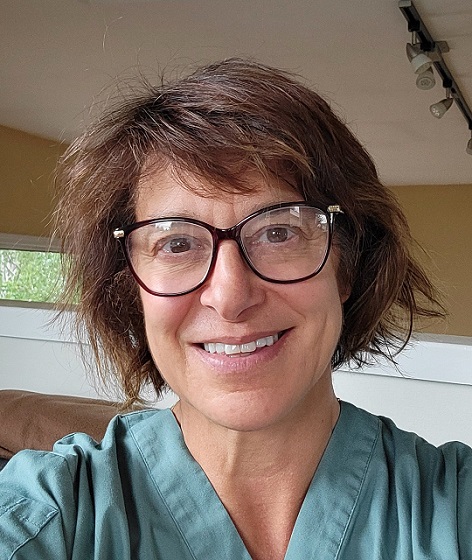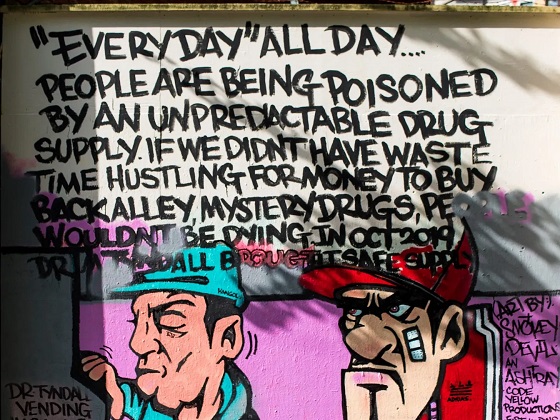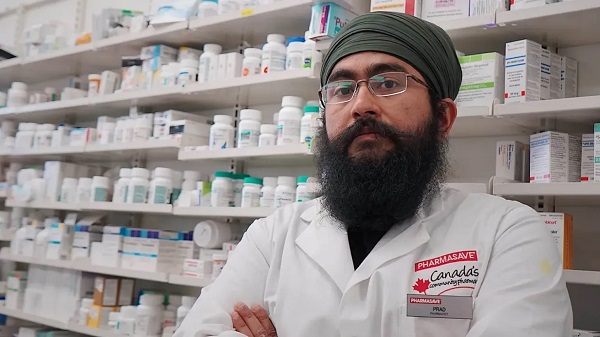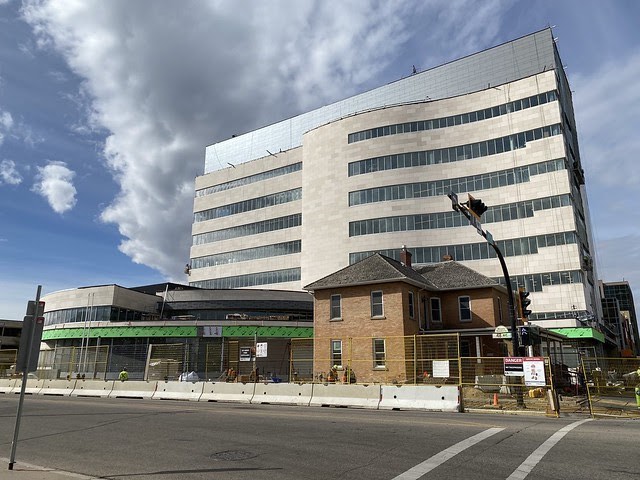Addictions
“Safer supply” reminiscent of the OxyContin crisis, warns addiction physician

Dr. Lori Regenstreif, MD, MSc, CCFP (AM), FCFP, MScCH (AMH), CISAM, has been working as an addiction medicine physician in inner city Hamilton, Ontario, since 2004. She co-founded the Shelter Health Network in 2005 and the Hamilton Clinic’s opioid treatment clinic in 2010, and helped found the St. Joseph’s Hospital Rapid Access Addiction Medicine (RAAM) clinic.
|
[This article is part of Break The Needle’s “Experts Speak Up” series, which documents healthcare professionals’ experiences with Canada’s “safer supply” programs] By: Liam Hunt
Dr. Lori Regenstreif, an addiction physician with decades of experience on the frontlines of Canada’s opioid crisis, is sounding the alarm about the country’s rapidly expanding “safer supply” programs.
While proponents of safe supply contend that providing drug users with free tablets of hydromorphone – a pharmaceutical opioid roughly as potent as heroin – can mitigate harms, Dr. Regenstreif expresses grave concern that these programs may inadvertently perpetuate new addictions and entrench existing opioid use.
She sees ominous similarities between safer supply and the OxyContin crisis of the late 1990s, when the widespread overprescribing of opioids flooded North American communities with narcotics, sparking an addiction crisis that continues to this day. Having witnessed the devastating consequences of OxyContin in the late 1990s, she believes that low-quality and misleading research is once again encouraging dangerous overprescribing practices.
Flashbacks to the OxyContin Crisis
Soon after Dr. Regenstreif received her medical license in Canada, harm reduction became the primary framework guiding her practice in inner-city Vancouver. This period coincided with Health Canada’s 1996 regulatory approval of oxycodone (brand name: OxyContin) based on trials, sponsored by Purdue Pharma, that failed to assess the serious risks of misuse or addiction.
Dr. Regenstreif subsequently witnessed highly addictive prescription opioids flood North American streets while Purdue and its distributors reaped record profits at the expense of vulnerable communities. “That was really peaking in the late 90s as I was coming into practice,” she recounted during an extended interview with Break The Needle. “I was being pressured to prescribe it as well.”
Oxycodone addiction led to the deaths of tens of thousands of individuals in the United States and Canada. As a result, Purdue Pharma faced criminal penalties, fines, and civil settlements amounting to 8.5 billion USD, ultimately leading to the company’s bankruptcy in 2019.
During the OxyContin crisis, patients would regularly procure large amounts of pharmaceutical opioids for resale on the black market – a process known as “diversion.” Dr. Regenstreif has seen alarming indications that safer supply hydromorphone is being diverted at similarly high levels, and estimated that, out of her patient pool, “15 to 20 out of maybe 40 people who have to go to a pharmacy frequently” have reported witnessing diversion.
Between one to two thirds of her new patients have told her that they are accessing diverted hydromorphone tablets – in many cases, the tablets almost certainly originate from safer supply.
Injecting crushed hydromorphone tablets pose severe health risks, including endocarditis and spinal abscesses. “I’ve seen people become quadriplegic and paraplegic because the infection invaded their spinal cord and damaged their nervous system,” said Dr. Regenstreif. While infections can be mitigated by reducing the number of times drug users inject drugs into their bodies, she says that safer supply programs do not discourage or reduce injections.
She further noted, “I’ve seen a teenager in [the] hospital getting their second heart valve replacement because they continue to inject after the first one.” The pill that nearly stopped the patient’s heart was one of the tens of thousands of hydromorphone tablets handed out daily via Canadian safe supply programs.
Her experiences are consistent with preliminary data from a scientific paper published by JAMA Internal Medicine in January, which found that safe supply distribution in British Columbia is associated with a “substantial” increase in opioid-related hospitalizations, rising by 63% over the first two years of program implementation — all without reducing deaths by a statistically significant margin.
While Dr. Regenstreif has worked in a variety of settings, from Ontario’s youth correctional system to Indigenous healing facilities in the Northwest Territories, her experiences in Australia, where she worked during a sabbatical year from 2013 to 2014, were particularly educational.
Australia has far fewer opioid-related deaths than Canada – in 2021, opioid mortality rates were 3.8 per 100,000 in Australia and 21 per 100,000 in Canada (a difference of over 500%). Dr. Regenstreif credited this difference to Australia’s comparatively controlled opioid landscape, where access to pharmaceutical narcotics is tightly regulated.
“Heroin had been a long-standing street opioid. It was really the only opioid you tended to see, because the only other ones people could get a prescription for were over-the-counter, low-potency codeine tablets,” she said. To this day, opioid prescriptions in Australia require special approval for repeat supplies, preventing stockpiling and street diversion.
No real evidence supports “safer supply”
Critics and whistleblowers have argued that Canadian safe supply programs, which have received over $100 million in federal funding through Health Canada’s Substance Use and Addictions Program (SUAP), were initiated without adhering to the rigorous evidentiary standards typically required to classify medication as “safe.”
Dr. Regenstreif shares these concerns and says that no credible studies show that safer supply saves lives, and that little effort is invested into exploring its possible risks and unintended consequences – such as increased addiction, hospitalization, overdose and illicit diversion to youth and vulnerable individuals.
Most studies which support the experiment simply interview recipients of safer supply and then present their answers as objective evidence of success. Dr. Regenstreif criticized these qualitative studies as methodologically flawed “customer satisfaction surveys,” as they are “very selective” and rely on small, bias-prone samples.
“If you have 400 people in a program, and you get feedback from 12, and 90% of those 12 said X, that’s not [adequate] data,” said Dr. Regenstreif, criticizing the lack of follow-up often shown safer supply researchers. “Nobody seems to track down the […] people who were not included. Did they get kicked out of the program? [Did they engage in] diversion? Did they die? We’re not hearing about that. It doesn’t make any sense in an empirical scientific universe.”
Safe supply advocates typically argue that opioids themselves are not problematic, but rather their unregulated and illicit supply, as this allows for contaminants and unpredictable dosing. However, studies have found that opioid-related deaths rise when narcotics, legal or not, are more widely available.
Dr. Regensteif is calling upon harm reduction researchers to build a more robust evidence base before calling for the expansion of safer supply. That includes more methodologically rigorous and transparent quantitative research to evaluate the full impact of Canada’s harm reduction strategies. Forgoing this evidence or adequate risk-prevention measures could lead to consequences as catastrophic as those resulting from Purdue’s deceptive marketing of OxyContin, she said.
Subscribe to our newsletter to get our latest news and analysis – or donate to our investigative journalism fund.
Critics propose solutions despite bullying
Dr. Regenstreif has faced pressure and exclusion for speaking out against safe supply. She estimates that while only a quarter of her local colleagues shared her doubts a few years ago, “now I would say more than half” harbor the same concerns. However, many are reluctant to voice their reservations publicly, fearing professional or social repercussions. “People who don’t want to speak out don’t want to be labeled as right-wing […] they don’t want to be labeled as conservative.”
While she acknowledges that safe supply may play a limited role for a small subset of patients, she believes it has been oversold as a panacea without adequate safeguards or due evaluation. “It doesn’t seem as if policymakers are listening to the people on the ground who have experience in doing this,” she said.
She contends that the solution to Canada’s addiction crisis lies in a more holistic, recovery-oriented approach that includes all four pillars of addiction: harm reduction, prevention, treatment, and enforcement. Her vision includes a national network of publicly-funded, rapid-access addiction medicine clinics with integrated counseling and wraparound services.
Additionally, Dr. Regenstreif stresses the importance of building upon established opioid agonist treatments (OAT), like methadone and buprenorphine, rather than solely relying on novel approaches whose social and medical risks are not yet fully understood.
At the core of Dr. Regenstreif’s advocacy lies a profound dedication to her patients and to the science of addiction medicine. “I like to think I kind of am fear-mongering with my patients, [by] trying to make them afraid of not getting better,” she explains. “I don’t want them to end up in the hospital and not come back out. I don’t want them to end up dead.”
[This article has been co-published with The Bureau, a Canadian media outlet that tackles corruption and foreign influence campaigns through investigative journalism. Subscribe to their work to get the latest updates on how organized crime influences the Canadian drug trade.]
2025 Federal Election
Study links B.C.’s drug policies to more overdoses, but researchers urge caution

By Alexandra Keeler
A study links B.C.’s safer supply and decriminalization to more opioid hospitalizations, but experts note its limitations
A new study says B.C.’s safer supply and decriminalization policies may have failed to reduce overdoses. Furthermore, the very policies designed to help drug users may have actually increased hospitalizations.
“Neither the safer opioid supply policy nor the decriminalization of drug possession appeared to mitigate the opioid crisis, and both were associated with an increase in opioid overdose hospitalizations,” the study says.
The study has sparked debate, with some pointing to it as proof that B.C.’s drug policies failed. Others have questioned the study’s methodology and conclusions.
“The question we want to know the answer to [but cannot] is how many opioid hospitalizations would have occurred had the policy not have been implemented,” said Michael Wallace, a biostatistician and associate professor at the University of Waterloo.
“We can never come up with truly definitive conclusions in cases such as this, no matter what data we have, short of being able to magically duplicate B.C.”
Jumping to conclusions
B.C.’s controversial safer supply policies provide drug users with prescription opioids as an alternative to toxic street drugs. Its decriminalization policy permitted drug users to possess otherwise illegal substances for personal use.
The peer-reviewed study was led by health economist Hai Nguyen and conducted by researchers from Memorial University in Newfoundland, the University of Manitoba and Weill Cornell Medicine, a medical school in New York City. It was published in the medical journal JAMA Health Forum on March 21.
The researchers used a statistical method to create a “synthetic” comparison group, since there is no ideal control group. The researchers then compared B.C. to other provinces to assess the impact of certain drug policies.
Examining data from 2016 to 2023, the study links B.C.’s safer supply policies to a 33 per cent rise in opioid hospitalizations.
The study says the province’s decriminalization policies further drove up hospitalizations by 58 per cent.
“Neither the safer supply policy nor the subsequent decriminalization of drug possession appeared to alleviate the opioid crisis,” the study concludes. “Instead, both were associated with an increase in opioid overdose hospitalizations.”
The B.C. government rolled back decriminalization in April 2024 in response to widespread concerns over public drug use. This February, the province also officially acknowledged that diversion of safer supply drugs does occur.
The study did not conclusively determine whether the increase in hospital visits was due to diverted safer supply opioids, the toxic illicit supply, or other factors.
“There was insufficient evidence to conclusively attribute an increase in opioid overdose deaths to these policy changes,” the study says.
Nguyen’s team had published an earlier, 2024 study in JAMA Internal Medicine that also linked safer supply to increased hospitalizations. However, it failed to control for key confounders such as employment rates and naloxone access. Their 2025 study better accounts for these variables using the synthetic comparison group method.
The study’s authors did not respond to Canadian Affairs’ requests for comment.
Subscribe for free to get BTN’s latest news and analysis – or donate to our investigative journalism fund.
Correlation vs. causation
Chris Perlman, a health data and addiction expert at the University of Waterloo, says more studies are needed.
He believes the findings are weak, as they show correlation but not causation.
“The study provides a small signal that the rates of hospitalization have changed, but I wouldn’t conclude that it can be solely attributed to the safer supply and decrim[inalization] policy decisions,” said Perlman.
He also noted the rise in hospitalizations doesn’t necessarily mean more overdoses. Rather, more people may be reaching hospitals in time for treatment.
“Given that the [overdose] rate may have gone down, I wonder if we’re simply seeing an effect where more persons survive an overdose and actually receive treatment in hospital where they would have died in the pre-policy time period,” he said.
The Nguyen study acknowledges this possibility.
“The observed increase in opioid hospitalizations, without a corresponding increase in opioid deaths, may reflect greater willingness to seek medical assistance because decriminalization could reduce the stigma associated with drug use,” it says.
“However, it is also possible that reduced stigma and removal of criminal penalties facilitated the diversion of safer opioids, contributing to increased hospitalizations.”
Karen Urbanoski, an associate professor in the Public Health and Social Policy department at the University of Victoria, is more critical.
“The [study’s] findings do not warrant the conclusion that these policies are causally associated with increased hospitalization or overdose,” said Urbanoski, who also holds the Canada Research Chair in Substance Use, Addictions and Health Services.
Her team published a study in November 2023 that measured safer supply’s impact on mortality and acute care visits. It found safer supply opioids did reduce overdose deaths.
Critics, however, raised concerns that her study misrepresented its underlying data and showed no statistically significant reduction in deaths after accounting for confounding factors.
The Nguyen study differs from Urbanoski’s. While Urbanoski’s team focused on individual-level outcomes, the Nguyen study analyzed broader, population-level effects, including diversion.
Wallace, the biostatistician, agrees more individual-level data could strengthen analysis, but does not believe it undermines the study’s conclusions. Wallace thinks the researchers did their best with the available data they had.
“We do not have a ‘copy’ of B.C. where the policies weren’t implemented to compare with,” said Wallace.
B.C.’s overdose rate of 775 per 100,000 is well above the national average of 533.
Elenore Sturko, a Conservative MLA for Surrey-Cloverdale, has been a vocal critic of B.C.’s decriminalization and safer supply policies.
“If the government doesn’t want to believe this study, well then I invite them to do a similar study,” she told reporters on March 27.
“Show us the evidence that they have failed to show us since 2020,” she added, referring to the year B.C. implemented safer supply.
This article was produced through the Breaking Needles Fellowship Program, which provided a grant to Canadian Affairs, a digital media outlet, to fund journalism exploring addiction and crime in Canada. Articles produced through the Fellowship are co-published by Break The Needle and Canadian Affairs.
Our content is always free – but if you want to help us commission more high-quality journalism,
consider getting a voluntary paid subscription.
Addictions
Addiction experts demand witnessed dosing guidelines after pharmacy scam exposed

By Alexandra Keeler
The move follows explosive revelations that more than 60 B.C. pharmacies were allegedly participating in a scheme to overbill the government under its safer supply program. The scheme involved pharmacies incentivizing clients to fill prescriptions they did not require by offering them cash or rewards. Some of those clients then sold the drugs on the black market.
An addiction medicine advocacy group is urging B.C. to promptly issue new guidelines for witnessed dosing of drugs dispensed under the province’s controversial safer supply program.
In a March 24 letter to B.C.’s health minister, Addiction Medicine Canada criticized the BC Centre on Substance Use for dragging its feet on delivering the guidelines and downplaying the harms of prescription opioids.
The centre, a government-funded research hub, was tasked by the B.C. government with developing the guidelines after B.C. pledged in February to return to witnessed dosing. The government’s promise followed revelations that many B.C. pharmacies were exploiting rules permitting patients to take safer supply opioids home with them, leading to abuse of the program.
“I think this is just a delay,” said Dr. Jenny Melamed, a Surrey-based family physician and addiction specialist who signed the Addiction Medicine Canada letter. But she urged the centre to act promptly to release new guidelines.
“We’re doing harm and we cannot just leave people where they are.”
Addiction Medicine Canada’s letter also includes recommendations for moving clients off addictive opioids altogether.
“We should go back to evidence-based medicine, where we have medications that work for people in addiction,” said Melamed.
‘Best for patients’
On Feb. 19, the B.C. government said it would return to a witnessed dosing model. This model — which had been in place prior to the pandemic — will require safer supply participants to take prescribed opioids under the supervision of health-care professionals.
The move follows explosive revelations that more than 60 B.C. pharmacies were allegedly participating in a scheme to overbill the government under its safer supply program. The scheme involved pharmacies incentivizing clients to fill prescriptions they did not require by offering them cash or rewards. Some of those clients then sold the drugs on the black market.
In its Feb. 19 announcement, the province said new participants in the safer supply program would immediately be subject to the witnessed dosing requirement. For existing clients of the program, new guidelines would be forthcoming.
“The Ministry will work with the BC Centre on Substance Use to rapidly develop clinical guidelines to support prescribers that also takes into account what’s best for patients and their safety,” Kendra Wong, a spokesperson for B.C.’s health ministry, told Canadian Affairs in an emailed statement on Feb. 27.
More than a month later, addiction specialists are still waiting.
According to Addiction Medicine Canada’s letter, the BC Centre on Substance Use posed “fundamental questions” to the B.C. government, potentially causing the delay.
“We’re stuck in a place where the government publicly has said it’s told BCCSU to make guidance, and BCCSU has said it’s waiting for government to tell them what to do,” Melamed told Canadian Affairs.
This lag has frustrated addiction specialists, who argue the lack of clear guidance is impeding the transition to witnessed dosing and jeopardizing patient care. They warn that permitting take-home drugs leads to more diversion onto the streets, putting individuals at greater risk.
“Diversion of prescribed alternatives expands the number of people using opioids, and dying from hydromorphone and fentanyl use,” reads the letter, which was also co-signed by Dr. Robert Cooper and Dr. Michael Lester. The doctors are founding board members of Addiction Medicine Canada, a nonprofit that advises on addiction medicine and advocates for research-based treatment options.
“We have had people come in [to our clinic] and say they’ve accessed hydromorphone on the street and now they would like us to continue [prescribing] it,” Melamed told Canadian Affairs.
A spokesperson for the BC Centre on Substance Use declined to comment, referring Canadian Affairs to the Ministry of Health. The ministry was unable to provide comment by the publication deadline.
Big challenges
Under the witnessed dosing model, doctors, nurses and pharmacists will oversee consumption of opioids such as hydromorphone, methadone and morphine in clinics or pharmacies.
The shift back to witnessed dosing will place significant demands on pharmacists and patients. In April 2024, an estimated 4,400 people participated in B.C.’s safer supply program.
Chris Chiew, vice president of pharmacy and health-care innovation at the pharmacy chain London Drugs, told Canadian Affairs that the chain’s pharmacists will supervise consumption in semi-private booths.
Nathan Wong, a B.C.-based pharmacist who left the profession in 2024, fears witnessed dosing will overwhelm already overburdened pharmacists, creating new barriers to care.
“One of the biggest challenges of the retail pharmacy model is that there is a tension between making commercial profit, and being able to spend the necessary time with the patient to do a good and thorough job,” he said.
“Pharmacists often feel rushed to check prescriptions, and may not have the time to perform detailed patient counselling.”
Others say the return to witnessed dosing could create serious challenges for individuals who do not live close to health-care providers.
Shelley Singer, a resident of Cowichan Bay, B.C., on Vancouver Island, says it was difficult to make multiple, daily visits to a pharmacy each day when her daughter was placed on witnessed dosing years ago.
“It was ridiculous,” said Singer, whose local pharmacy is a 15-minute drive from her home. As a retiree, she was able to drive her daughter to the pharmacy twice a day for her doses. But she worries about patients who do not have that kind of support.
“I don’t believe witnessed supply is the way to go,” said Singer, who credits safer supply with saving her daughter’s life.
Melamed notes that not all safer supply medications require witnessed dosing.
“Methadone is under witness dosing because you start low and go slow, and then it’s based on a contingency management program,” she said. “When the urine shows evidence of no other drug, when the person is stable, [they can] take it at home.”
She also noted that Suboxone, a daily medication that prevents opioid highs, reduces cravings and alleviates withdrawal, does not require strict supervision.
Kendra Wong, of the B.C. health ministry, told Canadian Affairs that long-acting medications such as methadone and buprenorphine could be reintroduced to help reduce the strain on health-care professionals and patients.
“There are medications available through the [safer supply] program that have to be taken less often than others — some as far apart as every two to three days,” said Wong.
“Clinicians may choose to transition patients to those medications so that they have to come in less regularly.”
Such an approach would align with Addiction Medicine Canada’s recommendations to the ministry.
The group says it supports supervised dosing of hydromorphone as a short-term solution to prevent diversion. But Melamed said the long-term goal of any addiction treatment program should be to reduce users’ reliance on opioids.
The group recommends combining safer supply hydromorphone with opioid agonist therapies. These therapies use controlled medications to reduce withdrawal symptoms, cravings and some of the risks associated with addiction.
They also recommend limiting unsupervised hydromorphone to a maximum of five 8 mg tablets a day — down from the 30 tablets currently permitted with take-home supplies. And they recommend that doses be tapered over time.
“This protocol is being used with success by clinicians in B.C. and elsewhere,” the letter says.
“Please ensure that the administrative delay of the implementation of your new policy is not used to continue to harm the public.”
This article was produced through the Breaking Needles Fellowship Program, which provided a grant to Canadian Affairs, a digital media outlet, to fund journalism exploring addiction and crime in Canada. Articles produced through the Fellowship are co-published by Break The Needle and Canadian Affairs.
Subscribe to Break The Needle
-

 armed forces2 days ago
armed forces2 days agoYet another struggling soldier says Veteran Affairs Canada offered him euthanasia
-

 Alberta1 day ago
Alberta1 day agoGovernments in Alberta should spur homebuilding amid population explosion
-

 conflict2 days ago
conflict2 days agoWhy are the globalists so opposed to Trump’s efforts to make peace in Ukraine?
-

 2025 Federal Election1 day ago
2025 Federal Election1 day agoCarney’s budget is worse than Trudeau’s
-

 International1 day ago
International1 day agoHistory in the making? Trump, Zelensky hold meeting about Ukraine war in Vatican ahead of Francis’ funeral
-

 Alberta1 day ago
Alberta1 day agoLow oil prices could have big consequences for Alberta’s finances
-

 Business1 day ago
Business1 day agoIt Took Trump To Get Canada Serious About Free Trade With Itself
-

 C2C Journal1 day ago
C2C Journal1 day ago“Freedom of Expression Should Win Every Time”: In Conversation with Freedom Convoy Trial Lawyer Lawrence Greenspon







